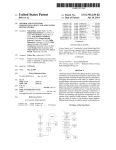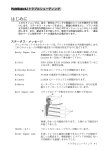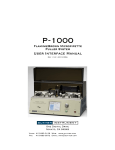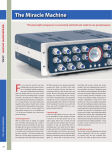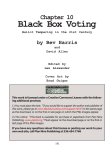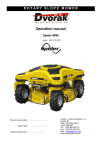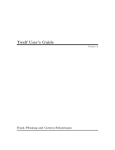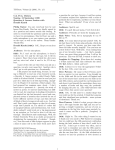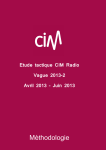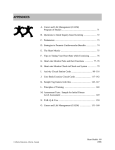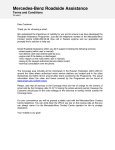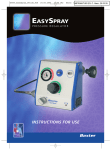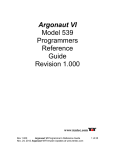Download Fanfare Magazine
Transcript
MAY / JUNE 2015 $12.00 The Magazine for Serious Record Collectors Lars Hannibal Featured in this issue 3beez Wax Box Music Management System Christopher Janwong McKiggan James Woodman Stefania de Kenessey Tobias van der Pals, Kristoffer Hyldig, and Elisabeth Zeuthen Schneider Varda Kotler Irina Bogdanova Robert Walzel Guido Sanchez-Portuguez Inês d’Avena Matthew Bengtson Ariel Halevy Bookshelves full of CDs are relics Enjoy music from the past, don’t live in it The Wax Music Management System brings the advantages of modern technology to collectors of recorded music. • Stores your entire CD collection in a box the size of a CD player. • Permits access to your recordings using a tablet from the convenience of your • Requires no other computer components favorite listening position. to play music from your collection. • Stores and plays downloads as well as CDs. • Provides exemplary sound quality with either digital or analog outputs. • Keeps your music collection safe from disaster and from the ravages of time. Wax is the only music management system designed for classical music lovers. • Store whatever information you want for each recording — orchestra, soloists, cast, etc. — in a format optimized by genre. • Distinguish multiple recordings of the same work easily. • Organize your collection by work, not by track, disc, or album. • Access Wikipedia and liner notes for additional information. • Partition your collection by genre and subgenre for easier access. A classical-music lover’s delight. 2015 Editors’ Choice Award, The Absolute Sound www.3beez.com Home Departments Classical Reviews Our Advertisers About Fanfare Contact Us Advertise Here search... Current Issue The 3beez Wax Box: New and Improved Departments - Feature Articles Written by Andrew Quint Tuesday, 26 May 2015 The 3beez Wax Box: New and Improved BY ANDREW QUINT Next Issue Listen to Audio Samples Subscribers, Enter the Fanfare Archive Subscribers, Renew Your Subscription Online Subscribe to Fanfare Magazine & Fanfare Archive Special Offers: Web-only Back in Fanfare 37:2, I evaluated the 3beez Music Management System and spoke with its creator, Jeffrey Barish. Since then, Barish’s original Wax Box, as his commercial product is called, has evolved into two new ones, Wax Box 2 and Wax Box 3. Both can fulfill the three main functions of computer audio—ripping and tagging CDs, downloading music files from the Internet, and streaming. For the first two processes, a unique and highly customizable music organization system is part of the package. There are two important differences between the two models. One is storage capacity. The larger Wax Box 2 (the enclosure measures 18.1” W x 13.4” D x 2.7” H) has two 3TB hard disk drives (HDDs) inside, while the Wax Box 3 (9.7” W x 8.8” D x 2.7” H) holds a pair of 1TB drives. In both cases, the second HDD holds an automatically generated backup of your music files, a “safety copy.” A second difference is that the smaller Wax Box 3 doesn’t have an optical disc drive (ODD)—that is, a drawer into which a user inserts a CD to be ripped. Instead, a Wax Box 3 owner provides his or her own ODD. I encountered Jeffrey Barish at the Rocky Mountain Audio Fest in Denver last October, and the Wax Box playing music for attendees sounded very good indeed. Subsequently, with the rush of the show behind him, Barish answered some questions that I had. You were pretty much a brand new company when the original Wax Box was written up in the Nov/Dec 2013 issue of Fanfare . How have things been going, and what have you learned, both in terms of technology and regarding the marketplace? Things have been going well! We now have Wax users all over the U.S. and in the UK. Their interest and feedback have been very gratifying. The right people recognize the power of Wax immediately, but even they seem to like it even more once they start using it. It is one thing to read about convenience, flexibility, power, and ease, and another to experience it. I was surprised to learn that the favorite feature among classical-music lovers is track groups. Track groups allow users to group the tracks for the individual acts of an opera, among many possible uses. I had assumed that the favorite feature would be “flexible metadata,” which permits users to describe recordings using sets of metadata unique to each genre. The favorite for pop-music lovers seems to be Wikipedia, which provides access to Wikipedia from within Wax to get more information about a recording, but they also Not To Be Missed! access to the Fanfare Archive $9.99/1 month, $39.99/1 year like being able to store the names of the members of a band. I designed Wax to meet my needs, but I am very pleased to see that it works well for other music lovers too. My biggest worry was that people would be intimidated by the effort required initially to rip their CD collection. It can be a big project, so no doubt some people have been put off, but I have gotten many reports that ripping was not as bad as people expected. Once people are familiar with the system, ripping most CDs is so routine that one user does it while reading a newspaper. Some people even say that it was fun and that it gave them an opportunity to reconnect with forgotten recordings. Ultimately, the end result amply rewards the effort. It is hard to appreciate without experiencing it how the convenience of having all your music with all the metadata you want plus liner notes, cover art, and Wikipedia available at the tap of a finger transforms the listening experience. Wax removes barriers to your exploration and enjoyment of music. We learned a lot about the market when we attended our first tradeshow last year, the Rocky Mountain Audio Fest. We were the 2014 winner of the Al Stiefel Legacy Award, an award bestowed by RMAF on an up-and-coming company with an innovative product. Over the course of the three-day show, we were astonished to have over 500 music lovers stop by our room for a demonstration of our product. We learned three important lessons from our conversations with these visitors: (1) Many music lovers are confused about the products and options available to them. They are interested in harnessing the advantages of modern technology, but their anxiety about making an inauspicious purchase has them paralyzed. (2) Many music lovers are wondering whether streaming services can meet their needs. (3) Audiophiles embrace opportunities to worry about threats to sound quality even where none exist; unless a product has the imprimatur of a trusted authority, they distrust their own opinion. And speaking of awards, we were just awarded a 2015 Editors’ Choice Award by The Absolute Sound, which is the leading publication for audiophiles. Along those lines, your web site (3beez.com) includes detailed comparisons between Wax Box and other products in the same class. You get pretty exhaustive and even a bit combative at times. Why did you feel it was important to do this? I had two reasons for providing this information at our web site. The product category for the Wax Box is new. As a result, things as basic as terminology are still evolving. Readers will encounter the terms network player, music player, digital audio player, media server, music server, streamer, or media renderer to describe similar products. The architecture of complete solutions varies. Most companies offer components that are part of a solution requiring two or three components (“media server,” “media renderer,” and perhaps a DAC [digital-to-analog converter]). The basic feature sets vary widely. Some products provide bulk storage, some don’t. Some products provide analog outputs, some don’t. Some products provide galvanic isolation, some don’t. The software that is the essence of these products varies widely in appearance, methods, features, and ease of use. Some products have separate programs for ripping and playing. Some programs require programming skills to perform certain tasks. Some have custom software; others use standard products or free software. The number of variables is bewildering to most people. We decided to help people with their buying decisions through the unorthodox technique of gathering objective information about competing products and presenting it in one place. We recognize that in doing so we might facilitate the sale of a competing product, but we are willing to place our faith in the decisions of wellinformed consumers. Which leads to my second reason for the comparisons at our web site: There is way too much misinformation circulating in this product category (and in the audio market generally). It is too easy for a charlatan to invent an audio “disease” for which his nostrum is the only remedy. And it is too hard for people lacking specific technical training to assess such claims themselves. To address this problem, I decided that we needed more at our web site than just a table of objective characteristics: We also needed to provide comments on the claims made by some of our competitors. At a minimum, I wanted to provide consumers ideas for questions to ask. For reviews of the products, I direct readers elsewhere. A claim that a product sounds better might be correct—I wouldn’t know because I most likely have not listened to the product—but I object to the ascription of superior sound to a nostrum for an imaginary disease. If a competitor has the technical expertise to identify a real problem and devise a real solution, they should prove it. It is critical that those of us in a position to do so combat the dissemination of misinformation. So, there are now two Wax Box models available, Wax Box 2 and Wax Box 3. Why did you feel you needed to keep available a model in a smaller enclosure, especially as it necessitates the compromise of eliminating the optical disc drive? For those looking for a “turnkey” system, this is something else to buy, right? Requiring a USB ODD is a departure from the turnkey idea, but it is a small one. When we describe our products as turnkey, we are attempting to differentiate them from the predominant system architecture, which involves at least two components: a “media server” and a “media renderer.” The media server stores the sound files; the media renderer streams sound files from the server over the network and plays them, possibly with the help of a DAC. This terminology comes from the UPnP specification, to which such products adhere to assure interoperability. Solutions based on this architecture require at least two purchase decisions. These two components must be compatible—which generally means that they must be DLNA compatible. DLNA specifies a lowest common denominator for metadata (basically album title, artist, track title, and genre) that is odious to classical music lovers and it does not provide support for gapless playback, which is anathema. UPnP is supposed to automate the interconnection of devices on the network, but it doesn’t always work; interconnection problems can be hard to diagnose and fix. If the network connection fails, playing music is impossible. Depending on the system, consumers might have to choose, purchase, and install music manager software. They will be responsible for enabling and performing backups. Customer support responsibilities could be divided among three companies or more. Wax Box 3 may require a USB ODD, but it does not have any of these other drawbacks. Many music lovers value a small case. A small component disrupts the aesthetics of a room less. In my audio system, I use a power amplifier that is the size of a power brick; together with a Wax Box 3 system, I was able to reduce my entire audio system and bookcases full of CDs to two compact components (plus loudspeakers) offering superb sound quality and greater convenience! Some users like to be able to transport their system to a second home. Once users complete the initial rip of their entire collection they typically idle the ODD for long periods. Wax Box 3 users can store the ODD in a drawer, if they choose, and pull it out on occasions when they need to rip a CD. The ODD connects to a USB port on the side of the case just behind the front panel, so users can make the connection easily without removing the Wax Box from its cabinet. Many music lovers already ripped their collections before purchasing a Wax Box. Wax now allows them to import their collection in one operation; if they then rely primarily on downloads to augment their collection, they need the ODD even less often. A smaller case also reduces cost and simplifies manufacturing, so we are able to offer Wax Box 3 at a lower price. Wax Box 2 rigorously adheres to the definition of turnkey, so we offer an option to music lovers who demand an internal ODD. Are there any particular external ODDs that you’re recommending?—I’m sure customers are asking. Knowing you’re of the “bits are bits” school, do you feel that the choice of ODD can make a significant difference sonically? I believe that the choice of ODD makes no difference sonically, especially in a Wax Box. Wax uses “secure ripping” to assure the accuracy of data extracted from CDs. Secure ripping means that Wax will read each block of data on the CD multiple times until the results are consistent. Thus, the accuracy of the extracted data is not dependent on the ODD. There is a widely held belief among audiophiles that fluctuations in the speed of a rotating medium will degrade the audio signal by introducing jitter. Like many audiophile fancies, the theory disintegrates on examination. The operating system (OS) reads blocks of data from the ODD and stores them in solid-state memory. Those data eventually find their way to the DAC, which reads them at a rate precisely determined by a clock associated with the DAC. Thus, variations in the speed of the ODD have no bearing on the rate at which the samples are converted to analog. In any case, Wax stores sound files on a HDD, making the ODD irrelevant. Some audiophiles believe that the spinning platters in a HDD are equally deleterious, but the same refutation applies: The OS reads blocks of data from the HDD and stores them in solid-state memory before they make their way to the DAC. If anyone is still not convinced, I have one more argument: Wax buffers sound files from the HDD in a solid state drive (SSD) so that it can turn off the HDD while playing to assure that the system is absolutely silent. Thus, nothing is spinning when Wax is playing, so any putative effects of spinning media are moot. The choice of ODD sometimes matters with CDs that are impaired. Most music lovers who rip their CD collection discover that many CDs are no longer completely playable. The discs might suffer from “disc rot” or other forms of deterioration. Sometimes one ODD can handle these defects when another cannot. Unfortunately, no ODD stands out. What changes have you made to the Wax Boxes 2 and 3 that improve the sound over the original? For those users who will not be employing an external DAC, are you building the devices with different DACs than used in the earlier model? Do you feel that Wax Boxes 2 and 3 sound any different than the original Wax Box? We are using a new DAC in Wax Box 2 and Wax Box 3 with a better signal-to-noise ratio and metal shielding around it to protect it from the electrical noise in the case. Most people will not notice the difference as the noise level was already very low, but the analog output is objectively better now. Most Wax users use the analog output, but a few are using an external DAC that they already owned. When using an external DAC, the Wax Box, like any such device, has essentially no impact on sound quality. A digital output provides a stream of numbers that represent the audio signal; those numbers are exactly the numbers stored in the sound archive during the ripping process. It is only when converting the numbers to analog in the DAC that it is possible for noise, jitter, and distortion to degrade the signal. Some of our competitors claim otherwise, so your readers should beware. Have you made any significant changes to the Wax Box software since the original model? Wax has several significant new features. I recently added support for liner notes. Many downloads are available with liner notes. Users can now store them along with the sound files and cover art to create a complete archive of a CD. Really dedicated collectors can scan liner notes. When Wax detects that a recording has liner notes, it presents a button that will open the liner notes in a document viewer. Another new feature makes it easier to enter characters with diacritics (as in Dvořák). Users can open a virtual keyboard on which many special characters appear. Clicking the desired character types it at the cursor. A related feature is automatic completion. Start typing the name of a composer or conductor and Wax will present a list of possible completions. Typing more characters narrows the choice. It is possible for users to add to the list either transiently or permanently and to create permanent completion lists for other metadata keys. Automatic completion helps keep spelling consistent and is another way to ease the inconvenience of entering diacritics. Another new feature that many classical music lovers appreciate is being able to reorder tracks. I have a 2-CD set of the Bach Cello Suites by Zuill Bailey. The release orders the suites 1, 3, and 5 on disc 1 and 2, 4, and 6 on disc 2. The Starker set does the same. The recordings by Yo-Yo Ma and Rostropovich have the suites ordered 1, 4, 5, 2, 3, 6. Most likely, the record producers chose the order to equalize utilization of the two CDs. With Wax, it has always been possible to create a single recording from the two CDs, but now users can move the suites into numerical order simply by dragging and dropping. You’re the engineer here, so rather than have me make mistakes in calculation, what are the approximate capacities of Wax Box 2 and 3 (in terms of the number of ripped CDs and CD-length downloads that will fit) with the most popular audio codecs? I always start with the number 1,300 CDs per TB. You get this number if you figure that a CD can store 737 MB of sound data, that every CD is maximally utilized, that a formatted 1 TB drive provides about 960 GB of usable space, and that the encoder provides no compression. The 3 TB drive in Wax Box 2 is sufficient for 3900 CDs. High-resolution (or “HD”) downloads require more space. A recording with a sample rate of 96 kHz and 24-bit resolution (“24/96”) consumes about three times the disk space of a CD, so only about 400 recordings will fit on a 1 TB HDD without any compression. The next question is “What encoding?” For some users, the answer is “None,” in which case these numbers are final. However, FLAC provides lossless compression, so there is no rational reason not to use it at a minimum. FLAC typically provides a compression ratio of 2:1, or even 2.5:1 for classical music. Thus, FLAC encoding extends the capacity of a 1 TB HDD to at least 2,600 CDs and perhaps over 3,200. Lossy encoders provide greater compression. Ubiquitous mp3 is often deprecated for poor sound quality, but the sound quality at higher bit rates is acceptable to most people. At 320 kb/s, a 1 TB HDD can store over 5,700 recordings. Note that Amazon encodes music downloads using mp3, but at 256 kb/s. However, they use a variable bit-rate algorithm, so its quality might still be acceptable to serious listeners. Among lossy encoders, I prefer Ogg. At any given bit rate, Ogg provides better sound quality than mp3 does. In my experience, few people can detect Ogg compression with a quality factor of 6; that quality level provides a compression ratio of around 7, in which case a 1 TB HDD can store over 9,000 recordings. As users are unlikely to need space for that many recordings, they could use a quality factor of 9 (over 5,700 recordings) or even 10 (over 3,600 recordings). Ogg may be less familiar to readers than mp3, but it was introduced 15 years ago. Most smart phones and portable media players support Ogg and Spotify uses Ogg. Readers should not dismiss lossy encoders. The only compelling reason to use FLAC (or WAV, an uncompressed format that takes up a lot of disc space) is that you expect to subject the recording to processing at some point (such as converting it to another encoding). Decoding the signal and then processing it can expose noise that previously was masked. Otherwise, small is good. Not only will you be able to store more recordings on the HDD, but backups will also be smaller, and transfers will be faster. Smaller files might make it possible to store your entire collection in your smart phone, on a flash drive, or in the cloud. So you still provide a backup hard drive in the Wax Box? Every Wax Box has two HDDs. One is for the sound archive and the other is for a backup. The sound archive and the time users spend creating it are precious, so it is critical to back up the sound archive regularly. Unfortunately, people often forget, especially as other audio devices do not require a backup. Moreover, backup systems that operate over the local network can fail quietly due to network problems. Building backup into the system adds cost, but increases security. Having a backup in the box also allows us to offer a way to protect users from their mistakes. Each Wax Box stores eight backups. If the user ever makes a mistake, it is possible to use the recover feature to restore the Wax Box to a state prior to the mistake. By default, Wax backs up the system once daily in the middle of the night, but users can create a backup manually at any time. Wax Box 2 is bigger so that we can use 3.5” HDDs. Both drives have a capacity of 3 TB. The smaller size of Wax Box 3 requires the use of 2.5” HDDs, which are available in capacities up to 1 TB, which is still plenty for most users. Even though the Wax Box performs backups automatically, I still advise users to create another backup periodically—one that they store at another site. That way, their collection is safe even in the event of the unthinkable. How would a user who wants to stream music from a high resolution site do this with Wax Box 3? All Wax Box systems support streaming through the web interface of the streaming service. Also, all Wax Box systems support high resolution audio up to 24 bits/192 kHz, so a streaming site that offers high resolution audio poses no problems. Serious music collectors—especially ones who listen to classical music—are rarely satisfied by streaming services. Although streaming services offer a large assortment, finding a particular recording can be tedious and the metadata available to complement the listening experience are limited. Some streaming services now support gapless playback, but you will not be able to specify gapless on a track-by-track basis (think Mendelssohn Violin Concerto). Nevertheless, a streaming service can serve for exploring and for background music. The Wax Box is already connected to the audio system and accessible over the LAN, so it is convenient to use it for these purposes. What is the pricing of the Wax Box 3 as opposed to Wax Box 2? 3beez doesn’t have a dealer network. Why have you chosen this business model for your product? To state the obvious, products in this category are different from amplifiers. Salesmen cannot simply turn on a Wax Box, adjust the volume, and then leave the customer to listen. We are not satisfied that any dealers have the technical expertise and commitment to showcase and support our products as proficiently as we require. Until they do, we prefer to eliminate the middleman and pass the savings on to our customers. We value the close relationships with our customers that the direct sale model entails. Because 3beez does not have a network of dealers, we offer three services instead. First, we can demonstrate the system to a potential customer over the Internet. Customers connect to a Wax Box from their home using a remote desktop viewer. They can watch me operate the system while I explain what I am doing, and they can operate the system themselves. Second, customers have 30 days to evaluate a system in their home; if they are unhappy with their purchase, they can return it to us in its original condition for a full refund. Finally, we offer to deliver a purchase personally, to help install and set up the Wax Box in our customer’s home, and to provide some initial training all at no charge (just travel expenses). In their standard configurations, Wax Box 2 is $5,400 (two 3 TB HDDs, one 960 GB SSD, and an internal ODD) and Wax Box 3 is $4,600 (two 1 TB HDDs and one 64 GB SSD). What kind of customer support do you provide? Do people require much “handholding” in the beginning from your experience over the last two years? Playing music with Wax is easy, but getting the system ready to play music is more complicated. Getting the Wax Box connected to the LAN is the first challenge that arises in some cases. The Wax Box can connect using either Ethernet or Wi-Fi, but sometimes neither is available at the audio system. Either HomePlug or a Wi-Fi range extender can solve these problems. Some users start by defining the genres that they will use to organize their collection. It makes sense to get the structure of the catalog right at the outset, although Wax does allow users to revise or create genres at any time and to move recordings from one genre to another. Defining a genre is not complicated, but it can be difficult to understand the implications of the choices one has to make before gaining more experience with the system. I configure the system for customers with the genres that I use; most users find that they serve at least customers with the genres that I use; most users find that they serve at least initially. Likewise, ripping involves choices whose significance can be hard to appreciate without more experience using the system. Wax makes it possible to create separate recordings from CDs with multiple works. If the CD holds multiple symphonies, then the choice is usually clear. But users often wonder what to do when there is one principal work and a filler piece—two recordings or one? How about a CD with many short symphonic pieces? Wax is accommodating, but initially the choices can be perplexing. I provide comments in the user manual and at the forum, but the best advice is to worry less because choices are not immutable. I provide unlimited support. I want all Wax users to be happy with the product, so I do everything in my power to make it so. First, before even delivering the system we offer to rip 10 of the customer’s CDs for free. That way, a new user can start using his or her new Wax Box by playing these familiar recordings. As I noted previously, I offer to deliver a purchase personally, to help install and set up the Wax Box in my customer’s home, and to provide some initial training all at no charge (just travel expenses). Our web site has links to videos showing how to perform various operations. Many users have reported that these videos were very helpful. The user manual is thorough, written in English, and liberally illustrated with screen shots. I update it whenever I change the software. We provide a forum at the web site at which users can share ideas and discuss issues. I respond to email. And finally, there is a lifesaver depicted on the desktop of every Wax Box. When users click it, they open a remote desktop viewer on my computer that allows me to step them through operations or investigate problems. What are your thoughts on DSD (Direct Steam Digital) as an audio codec being available to collectors wanting to archive their music at the highest possible level of fidelity? This isn’t a format that Wax supports. DSD is a strange choice for archival purposes as it has several fundamental technical flaws. The most basic flaw is that the one-bit representation that is the essence of DSD makes it impossible for recording engineers to manipulate the signal. Even changing the amplitude—the most basic of modifications—is not possible. As a result, engineers often use PCM for the recording and postproduction—just as they do for CDs and HD downloads—and then convert the final result to DSD. Or they might record in DSD, convert to PCM for postproduction, and then convert back to DSD for distribution. If PCM is flawed, then its flaws are irretrievably ingrained in DSD recordings too. All consumer products must continue to support PCM because it is ubiquitous, so the circuitry required for “native” decoding of DSD adds cost. Some companies obviate this special hardware by converting DSD to PCM. In so doing, they perfect an irony: The digital audio signal starts as PCM and ends as PCM, so what is the point of the conversion to and from DSD? Careful subjective studies have failed to reveal a significant difference in sound quality between DSD and PCM recordings. DSD has gained more traction in the market in its current recrudescence than I ever expected, but I still believe that it is a fad. I have heard wonderful DSD recordings. But I have also heard wonderful PCM recordings. What matters far more than the digital encoding technology is the care and expertise of the recording engineers. Music lovers would do better reading reviews in this publication to identify recordings with good sound quality than they would pursuing whimsical quests for superior technology. Any plans to sell the 3beez software by itself anytime soon? Many features of the Wax Box are tightly integrated with the operating system. Including them in a software product would constrain the platforms on which the software could run. We cache sound files in an SSD so that we can silence the HDD during play. What happens if a user installs the software on a system lacking an SSD (which few have)? The backup/restore features assume the presence of a second HDD. What happens if it is not there? We could design the software to adapt, but doing so complicates testing and support. We could omit features that require components not present in generic hardware, but then the software becomes more generic too. And then there is the biggest problem: Windows or OSX? Converting all the code to even one of these operating systems (the Wax Box runs Linux) would be arduous, and we would probably need to support both. We decided to offer a complete solution because many music lovers are interested in harnessing the capabilities of a system like ours, but they do not want to deal with technical complexity: selecting, installing, configuring, and mastering hardware and software components; working independently or with multiple vendors to resolve problems; in some cases, even learning scripting languages or regular expressions to achieve desired results when cataloging. We work hard to hide that complexity as much as possible. All that engineering is worth something; whether it is worth what we are asking only your readers can decide. To that end, they might like to refer to a table at our web site comparing our system objectively with several others. Many of those systems are more expensive than ours, some by a factor of three or more. Ours is not the least expensive system in the table, but we do provide a lot of features for the price —and ours is the only product to provide the Wax software. A software-only product would no doubt be less expensive, but it would also lack many of the advantages of our complete solution. I know you like to climb mountains in your spare time. You actually summited Kilimanjaro in 2014 and—how do I put this?—you’re no spring chicken. Is there a relationship between your passion for hiking and your passion for audio? People even older than I am (if you can imagine such a thing) have made the summit of Kilimanjaro. People confront challenges at all ages. Any challenge, whether it is reaching the summit of a tall mountain or developing and marketing an audio product, requires perseverance. When I started this audio project, I wanted a system for my personal use because nothing on the market met my needs. After ascending that metaphorical peak, I set my goals on an even higher one I discovered lurking behind the first, refining and marketing my prototype. When climbing Mt. Kilimanjaro, our African guides kept entreating us “pole, pole,” which means “slowly, slowly.” By focusing on taking one step and then another, one can make astonishing progress—all the way to 19,341 feet, perhaps. And so it has been on this project. A succession of many small steps has taken me from a crude prototype to a system that is rich with features, easy to operate, good looking, and pleasing even to the most discerning listeners. Along the way I have made many new friends all over the country. I don’t think that this mountain has a summit, but I am having so much fun climbing it that I expect to continue for as long as I can. Last Updated ( Tuesday, 26 May 2015 ) < Prev [ Back ] Next >










